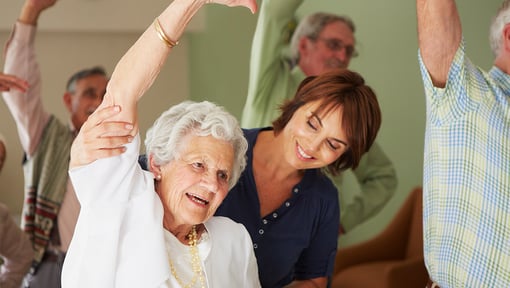Staying fit and eating a healthy diet forge a cornerstone of good health and well-being. They may be even more vital as you grow older. From keeping your bones and muscles strong to boosting your mood, sleep, and memory, eating well and getting routine exercise are crucial to staying healthy as you age.
Despite the importance of these 2 habits, sticking with them isn’t always easy. Barriers—such as a lack of time, energy, or motivation—may get in the way. But another hurdle that hinders many people? Popular myths about diet and exercise.
Myths can easily become deeply held beliefs even if they aren’t rooted in fact. And that, in turn, can keep you from taking steps to adopt healthy eating and exercise habits.
For example, maybe you’ve heard that it’s not safe to exercise after a certain age. Or that it won’t do any good. Or that your metabolism and digestion will be sluggish no matter what you do. These are fables. And, while separating fact from fiction can be tricky, it’s crucial that you do.
So, here’s a roundup of some of the most common food and fitness myths—and why it’s best to talk with your doctor before you take these to heart.
Let’s start with 4 common myths about fitness:
Fitness myth #1: I’m too old to exercise
Stop and ask yourself if you think growing older means you need to slow down, take it easy, and save your energy.
If you have such thoughts, you may have embraced the myth that exercise after a certain age is bad for you. But nothing could be further from the truth. The right types and amounts of exercise can help boost your strength, flexibility, endurance, and balance.
Rather than deplete you, an active lifestyle will give you energy and help you feel younger, healthier, and happier. The best news of all? No matter your age, it’s never too late to get and stay active and fit.
Here are 5 ways to push past some common barriers to working out.

Fitness myth #2: I’m too frail to be active
It’s true that as people grow older, they start to lose muscle mass and strength. Their bones may become weaker, too. But none of these age-related changes mean you should avoid exercise. In fact, the opposite is true.
Staying active can help slow the loss of muscle and bone strength. If you think you might have weak bones, ask your doctor about workouts that are safe for you. For example, water workouts and cycling are low impact. But skipping exercise altogether can raise your risk of becoming frail.
Even if you use a cane, walker, or wheelchair, don’t think that working out is unsafe. Your doctor or a physical therapist can help tailor a seated workout for you. You can also find fitness trainers who are certified to train people with certain health conditions. They can also help create a workout program that’s right for you and show you how to work out safely.

Fitness myth #3: It’s not safe to work out at my age
Some older adults are afraid of falling. Or they may feel that past injuries, arthritis, or other health problems may make exercise unsafe. But, with your doctor’s guidance, and taking some precautions, routine workouts can actually help ease the symptoms of many of these issues. They can help lessen back and knee pain. They can improve strength, flexibility, and balance. That can actually reduce the risk of falling.
Talk with your doctor first if you have joint pain, balance problems, or any health conditions. They can suggest safe exercises for you to try. Be sure to start slowly and pace yourself—especially if you’ve been inactive for a while. Start with seated exercises, if needed. At the very least, be sure you have grab bars or a sturdy chair to steady you in case you become unbalanced.
Doing too much too soon could leave you worn out, sore, or even hurt. You may end up frustrated, rather than motivated. Pushing yourself too hard may also worsen an existing health problem. Start where you are and build your fitness up gradually.
Looking for a safe, full-body workout that’s loads of fun? Look no further.

Fitness myth #4: I’ve been inactive too long and I’m too out of shape to exercise
This fitness myth is common among adults of all ages. But even if you’ve been inactive your entire life, it’s never too late to start. You can still get strong and fit. So if you’ve spent years on the couch and think you’ve crossed the point of no return, think again. You can start getting active at any age and any fitness level.
Even better, you can get and stay active for many years to come. Just be sure to talk with your doctor first if you have any health issues or haven’t been active in a while. Be sure to work out safely and with proper form at all times. If needed, begin with seated exercises if you’re worried about balance.
Looking for a simple way to ease back into getting more active? Why not give plogging a try?
And now, here are 4 common myths about food and eating:
Food myth #1: I can eat anything I want once I reach a certain age
As you get older, it’s just as important to eat nutrient-rich foods. But you may find it hard to shop for healthy foods and cook healthy meals. As a result, you may not eat enough whole grains, protein, or fresh veggies and fruits. And it may be tempting to eat more packaged and processed foods.
But older adults tend to need extra vitamins and minerals. And eating too many packaged foods may not give you those extra nutrients to stay at your healthy best.
Here’s a tasty way to get extra protein into your diet.

Food myth #2: Constipation is a normal part of aging that I can’t do anything about
It’s true that the movement of your digestive tract can slow down as you age. But that doesn’t mean you can’t do anything to remedy it. Very often, eating more high-fiber foods like fresh veggies and fruits, whole grains, beans and legumes, and dried fruits will help get things moving again.
Drinking enough fluids each day can also help. And if you sometimes ignore the urge to go when you need to, try to change that habit. It can make constipation worse.

Food myth #3: If I’m not hungry, it’s OK to skip meals because I don’t need as many calories anymore
Appetite tends to decrease in many older adults. This may be due to changes in taste and smell that can cause foods to lose flavor. Some medicines can decrease your sense of hunger, too. But even though you may need fewer calories as you age, that doesn’t mean it’s OK to drastically cut back how much you eat—or to skip meals.
Start by adding more flavor and aroma to your food. Skip the salt shaker and, instead, add herbs and spices to bump up the taste factor in a healthy way. If you really can’t muster the desire to eat, talk with your doctor. It may be a sign of an underlying health problem. Your doctor may recommend a change in medicines.

Food myth #4: If I’m not thirsty, I don’t need to drink water or other fluids
Many adults tend to lose their sense of thirst as they grow older. You may be less likely to drink enough fluids. That can leave you more prone to dehydration.
Be sure to talk with your doctor to find out how much and which types of fluids are best for you each day. Hot, humid weather, exercise, and certain health conditions can affect how much you need to drink.

Make an effort to separate the myths from the facts
These are just a few of the many food and fitness fallacies out there. The best way to sort fact from fiction is to do your homework. Visit websites you can trust. Or talk with your doctor, a nutritionist, or a physical therapist about other food and fitness myths that may be keeping you from the road to good health.
Not a Silver&Fit® member? Learn more about everything the program has to offer, including more helpful healthy living tips like this, here on our website.
This information is not intended to take the place of regular medical care or advice. Please check with your doctor before using this information or beginning any self-care program. Images used for this article do not depict any members of the Silver&Fit Program.
References
Hobbins, N. (2018, May 1). Top 10 myths regarding nutrition for seniors. Hospital + Healthcare. https://www.hospitalhealth.com.au/content/aged-allied-health/article/top-10-myths-regarding-nutrition-for-seniors-467328162
Liu, C. K., Fielding, R. A. (2011). Exercise as an intervention for frailty. Clinics in Geriatric Medicine, 27(1), 101-110. https://doi.org/10.1016/j.cger.2010.08.001
National Council on Aging. (2021, August 30). The lifechanging benefits of exercise after 60. https://ncoa.org/article/the-life-changing-benefits-of-exercise-after-60
National Institute on Aging. (n.d.) Healthy eating, nutrition, and diet. https://www.nia.nih.gov/health/topics/healthy-eating-nutrition-and-diet
National Institute on Aging. (2022, February 28). How much should I eat? Quantity and quality. https://www.nia.nih.gov/health/how-much-should-i-eat-quantity-and-quality
National Institute on Aging. (n.d.). Exercise and physical activity: Your everyday guide from the National Institute on Aging. Introduction. https://www.nia.nih.gov/health/publication/exercise-physical-activity/introduction
National Institute on Aging. (2020, April 3). How older adults can get started with exercise. https://www.nia.nih.gov/health/how-older-adults-can-get-started-exercise
Schneider, E. (2022, February 3). Nutrition and aging: 11 myths and misconceptions. University of Southern California, Leonard Davis School of Gerontology. https://gero.usc.edu/2022/02/03/nutrition-and-aging-myths-and-misconceptions/
WorldHealth.net. (2023, February 22). Busting some myths about exercise benefits for seniors. https://www.worldhealth.net/news/busting-some-myths-about-exercise-benefits-seniors/
This article was written by Gail Olson, edited by Jason Nielsen, and clinically reviewed by Elizabeth Thompson, MPH, RDN.





